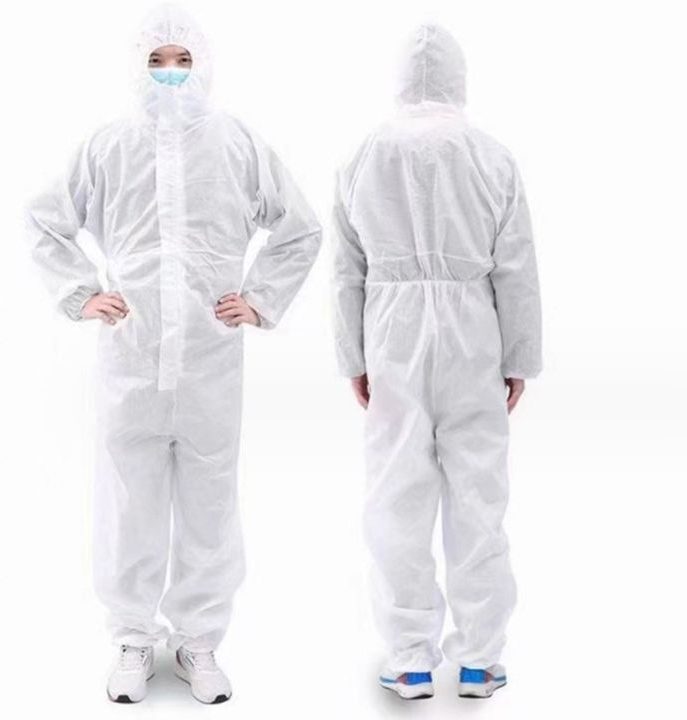SMS-PP-Microporous are three of the most widely used non-woven fabrics in medical protective apparel, especially in professional medical environments that are constantly exposed to infection risks and harmful agents. Medical protective apparel plays an extremely crucial role as not only essential equipment but also the first line of defense to maximally protect medical staff and workers. However, the protective effectiveness, production cost, and wearing comfort of protective apparel depend directly on the type of material used. So, how do you choose the most optimal fabric that meets specific needs?
This article will guide you to explore in-depth the three most popular non-woven fabrics in the medical industry today: SMS, PP, and Microporous. We will compare their effectiveness in detail, evaluate the pros and cons of each type, and help you make the most suitable choice for medical coveralls and gowns — ensuring safety and optimizing costs in all situations.
I. Overview of Common Non-Woven Fabrics in Protective Apparel
1. What is Non-Woven Fabric?
Non-woven fabric is a special type of material created from chemical or natural fibers such as SMS-PP-Microporous. The biggest difference is that they are bonded together by mechanical, chemical, or thermal methods, without needing a traditional weaving process (interlacing warp and weft threads). This gives non-woven fabrics distinct advantages: they are lightweight, inexpensive, easy to mass-produce, and particularly suitable for single-use products.
2. Required Criteria for Fabrics Used in Protective Apparel
To ensure optimal protection in a medical environment, fabrics used for protective apparel must meet the following important criteria:
- Liquid/Fluid Resistance: This is a key factor to prevent the penetration of blood, body fluids, and harmful chemical liquids.
- Bacterial/Viral Filtration Capability: The fabric must be able to create a physical barrier, limiting the spread of pathogens.
- Breathability and Moisture Wicking: Ensures comfort, reduces heat and stuffiness for the wearer, especially during prolonged use.
- Mechanical Strength and Flexibility when Worn: The fabric needs to be durable enough to withstand impacts during use and flexible enough for the wearer to move easily.
- Biological Safety: Does not cause skin irritation, does not contain harmful substances, ensuring absolute safety for users.
- Skin-friendliness: Provides a comfortable feeling, avoiding discomfort upon direct skin contact.
II. SMS-PP-Microporous: Introduction to Each Non-Woven Fabric
1. PP Fabric (Polypropylene Spunbond)
PP (Polypropylene Spunbond) fabric is made from 100% virgin Polypropylene pellets. The process involves drawing PP fibers into fine threads, then bonding them together with heat and pressure. This is the lowest-cost non-woven fabric in the three types, often used for single-use protective apparel in low-risk environments, for example, medical gowns or coveralls for visitors.
2. SMS Fabric (Spunbond – Meltblown – Spunbond)
SMS fabric is an acronym for Spunbond – Meltblown – Spunbond, representing the special three-layer structure of this fabric. The Meltblown layer in the middle is composed of ultra-fine fibers, which enhance its ability to filter bacteria, dust, and effectively resist fluid penetration. The two outer Spunbond layers provide durability and abrasion resistance to the fabric. Thanks to this design, SMS fabric offers significantly higher protection compared to PP fabric, while maintaining relative softness and breathability, making it suitable for coveralls and medical gowns used in medium-risk environments.
3. Microporous Fabric
Microporous fabric is uniquely structured from a thin microporous membrane heat-pressed or laminated onto a base fabric layer (often PP or another type of non-woven fabric). The special feature of this Microporous membrane is that it has billions of tiny pores (super-small in size, only allowing moisture vapor to pass through but not liquid). Thanks to this special structure, Microporous fabric possesses extremely high liquid resistance and antibacterial properties, while still maintaining a certain degree of breathability. This is an optimal choice for medical coveralls and gowns in high-risk environments, requiring maximum protection.
III. Comparing the Effectiveness of SMS-PP-Microporous in Medical Protective Apparel
-
PP fabric has low fluid resistance and bacterial filtration capabilities, making it suitable for low-risk environments. However, this fabric excels in high breathability and has the lowest cost. In terms of mechanical durability, PP is average and feels quite breathable but not very soft.
-
Next is SMS fabric, a significant improvement. SMS exhibits medium to high fluid resistance and significantly better bacterial filtration compared to PP. Although the breathability of SMS is average, it compensates with high mechanical durability and provides a soft, comfortable feel when worn. The cost of SMS is medium, higher than PP.
-
Finally, Microporous fabric stands out with superior fluid resistance, reaching a very high level, along with strong bacterial filtration capabilities. Although its breathability is average and it might feel somewhat stuffy if worn for extended periods, the protective effectiveness of Microporous is the most outstanding, especially in high-risk environments. Its mechanical durability is average, and it is also the most expensive among the three types.
IV. SMS-PP-Microporous in Different Types of Medical Protective Products
1.SMS-PP-Microporous In the Production of Medical Coveralls
- PP: Only suitable for tasks that do not involve direct contact with fluids or in low-risk environments, for example, cleaning staff, maintenance workers in hospitals, or visitors.
- SMS: Is a good choice for medical staff providing general patient care, working in clinics, hospitals, or medical facilities with medium infection risks.
- Microporous: Is ideal for use in environments requiring the highest level of protection such as operating rooms, isolation areas for infectious diseases, medical waste disposal areas, or when performing stringent disinfection procedures.
2. SMS-PP-Microporous In the Production of Medical Gowns
- PP: Suitable for single-use gowns with low cost, used in areas with minimal fluid contact and not requiring a high level of protection (for example, general clinics, quick examinations).
- SMS: With good durability and antibacterial properties, SMS gowns can be used more effectively in areas requiring a higher level of protection than PP.
- Microporous: Provides superior fluid and liquid resistance, making Microporous gowns the best choice in environments with a lot of liquids, infusions, blood, or when maximum protection against infection is needed.
V. SMS-PP-Microporous: Pros and Cons of Each Fabric Type
1. Pros – Cons of PP Fabric
- Pros: Inexpensive, lightweight, and simple manufacturing process, easy for mass production.
- Cons: Poor protection, especially ineffective against liquid penetration, easily absorbs water and bacteria, only suitable for low-risk environments.
2. Pros – Cons of SMS Fabric
- Pros: Good antibacterial and fluid-resistant properties compared to PP, providing significant protective effectiveness. At the same time, SMS fabric is also quite soft and skin-friendly, creating a comfortable feeling when worn.
- Cons: Higher cost than PP. Sometimes can cause a feeling of less breathability than pure PP if worn in hot environments or for long periods. Not as effective against strong liquid penetration as Microporous.
3. Pros – Cons of Microporous Fabric
- Pros: Best liquid resistance, providing the highest effectiveness in high-risk environments. Superior ability to block bacteria and viruses.
- Cons: Highest cost. Can cause stuffiness and less breathable feeling if worn for long periods.
VI. How to Choose SMS-PP-Microporous Fabric Based on Usage Purpose
- PP: Suitable for low-risk environments, short-term use, or for visitors (for example, administrative areas, meeting rooms in hospitals).
- SMS: Is an ideal choice for medical staff, nurses, or those working in general patient care environments, clinics, or areas with medium infection risks.
- Microporous: Is suitable and recommended for surgical procedures, isolation areas, prevention of dangerous harmful agents, or areas with high exposure to blood and body fluids.
VII.Trends in Using SMS-PP-Microporous Non-Woven Fabrics in Protective Apparel
The medical protective apparel industry is witnessing significant changes. The demand for single-use medical protective apparel (SMS-PP-Microporous) with superior antibacterial and anti-fluid capabilities is increasing rapidly. This drives manufacturers to continuously research and develop, sometimes combining multiple materials (for example: SMS combined with Microporous coatings or other reinforcing layers) to optimize protective effectiveness while ensuring comfort.
In the future, this industry is also moving towards developing products that can be reused after specialized processing, along with biodegradable non-woven fabrics that are more environmentally friendly, contributing to reducing medical waste.
VIII. Frequently Asked Questions (FAQs)
1. Can PP fabric be washed and reused? PP fabric in medical protective apparel is generally designed for single use and should not be washed or reused. Washing can damage the protective structure of the fabric, thereby significantly reducing its fluid resistance and bacterial filtration effectiveness.
2. How can I differentiate between protective apparel made from SMS or Microporous fabric? Typically, fabric material information will be clearly stated on the product label or packaging. Visually, Microporous fabric often feels slightly stiffer and may make a faint rustling sound more than SMS, and its surface also tends to be smoother and shinier.
3. Is Microporous fabric completely waterproof? Microporous fabric has extremely good, almost complete waterproofing capabilities against most common liquids due to its unique microporous membrane structure. However, under extremely high pressure or when exposed to certain specific chemicals, its waterproofing effectiveness may have some limitations.
4. Is protective apparel made from SMS fabric safe enough for surgery? For general or minimally invasive surgical procedures, SMS fabric can meet the required level of protection. However, for surgeries with a high risk of extensive exposure to blood and body fluids, or complex surgeries requiring the highest level of sterility, Microporous fabric or other specialized fabrics with superior fluid resistance and bacterial filtration capabilities will be prioritized to ensure maximum safety.
Call To Action
We hope this article has provided you with a comprehensive overview of non-woven fabrics in protective apparel manufacturing. To get more detailed advice and explore quality medical coverall and gown products made from SMS, PP, Microporous, please visit our website at 8688.vn or call us immediately for free consultation and comprehensive, standard-compliant protective apparel solutions.

